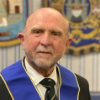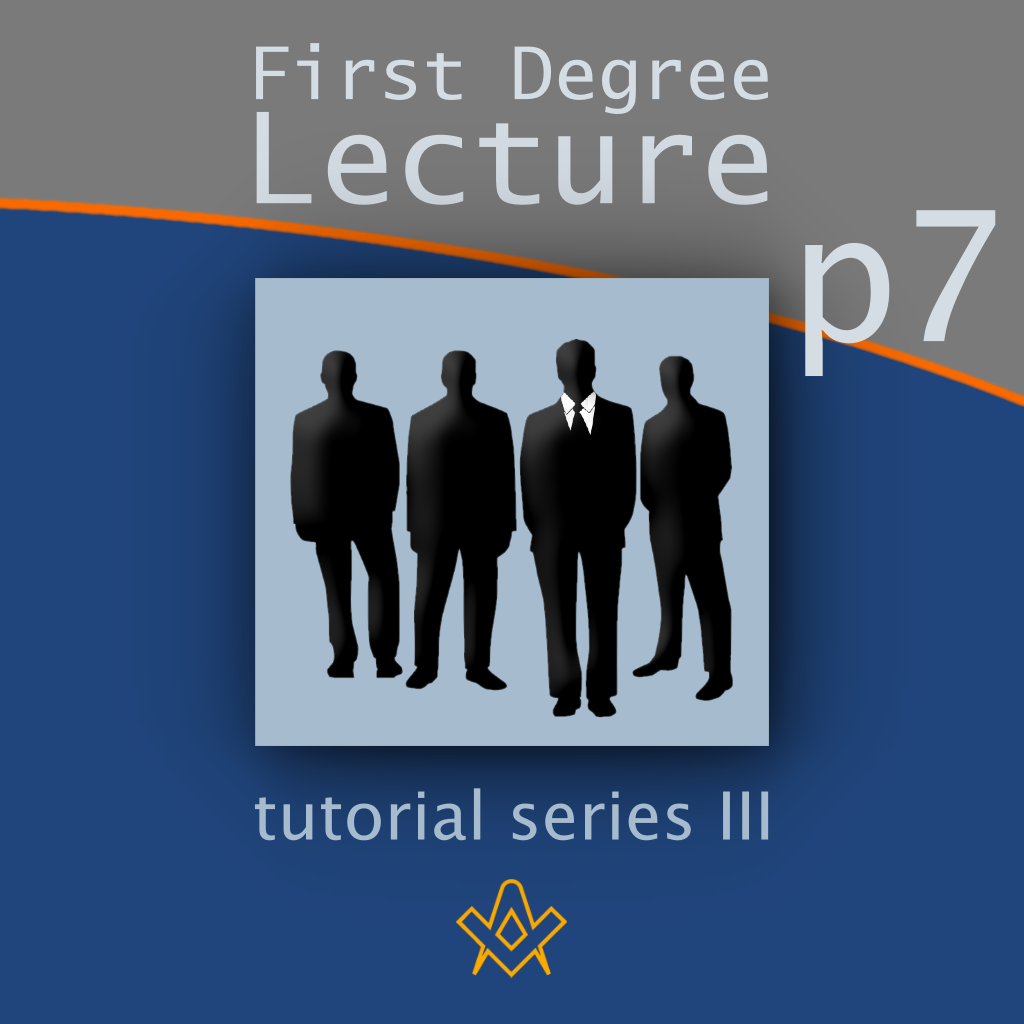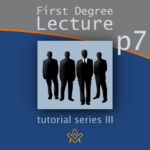Mentor’s Notes – Learning Outcomes
By the end of this tutorial the learner will be able to:
• Explain what is learnt by being a Freemason
• Explain the emblems if Freedom, Fervency. zeal.
• Explain the reason we are called Freemasons
• Identify how a Lewis is depicted in our Lodges.
• Explain the distinguishing
The First Degree Lecture, Section Seven, by William Preston.
Video Presentation
In section six, Preston describes the virtues required of a Freemason and the foundations of Freemasonry.
In this, the last section of the First Degree Lecture by William Preston he explains, through questions and answers, the responsibilities of a Lewis and the distinguishing characteristics of a Freemason. Read, learn and enjoy.
Stephen J. Goulding PPJGD. SLGCR.
Q. – How many sorts of Masons are there?
A – Two: Free and Accepted, and Operative.
Q – Which of those are you?
A – Free and Accepted.
Q – What do you learn by being a Free and Accepted Mason?
A – Secrecy, Morality, and Good Fellowship.
Q – What do Operative Masons learn?
A – The useful rules of Architecture; to hew, square, and mould stones into the formation required for the purposes of building; and unite them by means of joints – level, perpendicular, or otherwise; and by the aid of cement, iron, lead, or copper; which various operations require much practical dexterity and some skill in geometry and mechanics.
Q – And what by being both, and frequenting sundry Lodges?
(NOTE: That is being both Operative and Free and Accepted Masons.)
A – To act on the square, observe a proper deportment in the Lodge, pay due and becoming respect to the Worshipful Master and his presiding officers, to abstain from all political or religious disputes which might breed dissension among the Brethren, and in time entail a scandal on the Craft.
Q – In what degree in Freemasonry were you initiated?
A – That of an Entered Apprentice.
Q – How long should an Entered Apprentice serve his Master?
A – Seven years is the stipulated time; but less will suffice, if found qualified for preferment.
(NOTE: Seven years as an ‘Operative’ Apprentice. Going back to the ‘Guilds’.)
Q – How should he serve him?
A – With Freedom, Fervency, and Zeal.
Q – Excellent qualities; what are their emblems?
A – Chalk, Charcoal, and Clay.
Q – Why?
A – Nothing is more free than Chalk; the slightest touch leaves a trace. Nothing more fervent than Charcoal; for when properly lighted no metal can resist its force. Nothing more zealous than Clay, our mother Earth; she is continually labouring for our support. Thence we came, and there we must all return.
Q – If you wished to give your son a Masonic name, what would you call him?
A – Lewis.
Q – What does Lewis denote?
A – Strength.
Q. – How is it depicted in our Lodges?
A – By certain pieces of metal dovetailed into a stone, forming a cramp; and when in combination with some of the mechanical powers, such as a system of pulleys, it enables the Operative Mason to raise great weights to certain heights with little encumbrance, and to fix them on their proper bases.
(NOTE: You will find the cramp or Lewis attached to the Smooth Ashlar on the Senior Warden’s pedestal. You will also note that the ashlar is suspended with all its weight bearing on the Lewis.)
Q – Lewis being the son of a Mason, what is his duty, to his aged parents?
A – To bear the heat and burden of the day, which they by reason of their age, ought to be exempt from; to assist them in time of need, and thereby render the close of their days happy and comfortable.
Q – His privilege for so doing?
A -That of being made a Mason before any other person, however dignified.
Q -Why are we called Freemasons?
A – Because we are free to, and free from.
Q – Free to, and free from what?
A – Free to good fellowship, and ought to be free from vice.
Q – If a Mason of this description were missing, where would you expect to find him?
A – Between the Square and Compasses.
Q – Why there?
A – Because by acting on the one he would be sure to be found within the other.
Q – How would you clothe your Mason?
A – With the distinguishing badge of a Mason.
(NOTE: “A badge more ancient than the Golden Fleece or Roman Eagle. More honourable than the Garter or any other order in existence it being the Badge of innocence and the bond of friendship.” Ritual.)
Q – How do you know a Mason in the day?
A – By seeing him, and observing the Sign.
Q – How in the night?
A – By receiving the Token, and hearing the Word.
Q – How blows the wind in Freemasonry?
A – Favourably, due East or West.
Q – For what purpose?
A – To cool and refresh men at labour.
Q – It has a further allusion?
A – To that miraculous wind which proved so essential in working the happy deliverance of the children of Israel from their Egyptian bondage.
Q – Why is the wind deemed favourable to Freemasonry in only those particular points of the Compass?
A – When The Great Architect of the Universe thought proper to deliver His chosen people from their Egyptian bondage, He commanded His faithful servant Moses to lead them towards the land of Canaan, which He had promised them for an inheritance: he accordingly conducted them through the desert to the extremity of Egypt, where they encamped for the night on the borders of the Red Sea.
Pharaoh, regretting the loss of many useful slaves, he gathered together a mighty army of horse, foot, and chariots in order to bring them back for their captivity, not doubting of success, as he knew that the Israelites were unarmed and undisciplined, and that their journey was impeded by cattle and baggage.
The Israelites, seeing the Red Sea in the front, the impassable mountains on the right and left, and the Egyptian army rapidly advancing in their rear, murmured against their leader, and said;
“Why hast thou brought us into the wilderness to perish? Was there not ground enough in Egypt for our internment?”
But Moses spoke comfortably to them, and bade them be of good cheer; for on that day they should experience the salvation of the Lord.
He then, after a fervent prayer to the throne of grace, stretched his sacred rod over Red Sea, which caused a strong east wind to blow, dividing the waters that they stood as a wall on each side, affording Israelites a passage through on dry land.
Pharaoh seeing this, followed them without hesitation, and already deemed the fugitives within his power, when, in order to check his presumption, the Almighty sent a miraculous pillar of fire and cloud, which had two wonderful effects; the fire gave light to Israelites and facilitated their progress; the cloud proved darkness to Pharaoh and followers, and retarded their march.
Then sent a further impediment to the enemy, which was an angel who struck off their chariot-wheels, occasioning them to drag heavily, so that the Egyptian army and the children of Israel came not together.
At the dawn of day, Pharaoh, perceiving the hand of the Lord work sorely against him gave order to his troops to discontinue the pursuit, and return by the way they came; but it was then too late, for by that time the Israelites had gained the opposite coast; when Moses bade them look back on their long-dreaded enemies, for from that time forward they should see them no more; he then again stretched his sacred rod over the waters, which caused them to burst their invisible chains, and rush into their primitive channel, overwhelming Pharaoh and all his host.
In commemoration of this happy deliverance, the children of Israel went many days’ journey into the wilderness, singing psalms and thanksgiving to their Omnipotent deliverer; since which period the wind in due East or West has been deemed favourable to Freemasonry.
(NOTE: Bible Old Testament: The Book of Exodus)
Q – What are the distinguishing characteristics of a good Freemason?
A – Virtue, Honour, and Mercy and may they ever be found in a Freemason’s breast.
Q – I will thank you to define VIRTUE.
A – In reading the history of ancient Rome, we find that the Consul Marcellus intended to erect a Temple to be dedicated to Virtue and Honour; but being prevented, at .that time, from carrying his design into execution, he afterwards altered his plans, and erected two Temples, contiguous to each other, so situated that the only avenue to the Temple of Honour was through that of Virtue; thereby leaving an elegant moral to posterity, that Virtue is the only direct road to Honour.
(NOTE: Consul Marcellus shows us that by ingenuity and lateral thinking any obstacle can be overcome. “Virtue – the only direct road to Honour”)
A – Virtue is the highest exercise of, and improvement to, reason; the integrity, harmony, and just balance of affection; the health, strength, and beauty of the soul.
The perfection of Virtue is to give reason its full scope; to obey the authority of conscience with alacrity; to exercise the defensive talents with fortitude, the public with justice, the private with temperance, and all of them with prudence; that is, in a due proportion to each other, with a calm and diffusive beneficence; to love and adore God with an unrivalled and disinterested affection and to acquiesce in the dispensations of Divine providence with a cheerful resignation.
Every approach to this standard is a step towards perfection and happiness, and any deviation therefrom has a tendency to vice and to misery.
(NOTE: Once again Preston shows us what a wonderful wordsmith he is in explaining this Masonic characteristic. The tassels on the four corners of the Masonic carpet refer to the four virtues – Prudence, Fortitude, Temperance and Justice. And as we square the Lodge in our perambulations these virtues are constantly being drummed into our subconscious.)
A – May justly be defined to be the spirit and supererogation (Meaning: Saintly and heroic acts. (Oxford Dictionary)) of Virtue; the true foundation of mutual faith and credit; and the real intercourse by which the business of life is transacted with safety and pleasure.
It implies the united sentiments of Virtue, Truth, and Justice, carried by a generous mind beyond those mere moral obligations which the laws require, or can punish the violation of.
True Honour, though a different principle from religion, is that which produces the same effects; the lines of action although drawn from different parts, terminate in the same point.
(NOTE: Honour – the quality of both knowing and doing what is morally right. (Oxford Dictionary))
A – Religion embraces Virtue, as it is enjoined by the laws of God; and Honour, as it is graceful and ornamental to human nature.
The religious man fears, the man of Honour scorns, to do an ill action; the latter considers vice as something beneath him; the other as something which is offensive to the Divine Being.
A true man of Honour will not content himself with the literal discharge of the duties of a man and a citizen; he raises and signifies them to magnanimity: he gives, when he may, with propriety refuse; and forgives, where he may with justice resent.
The whole of his conduct is guided by the noblest sentiments of his own unvitiated heart; a true moral rectitude of the uniform rule of his actions; and a just praise and approbation his due reward.
(NOTE: Just take a moment and reflect upon the sentence Preston has written: “The religious man fears (to do an ill action) whilst the man of honour scorns to do an ill action.”)
Q – MERCY?
A – Is a refined virtue, and when possessed by the monarch, adds a lustre to every gem that adorns his crown; if by the warrior, it gives an unceasing freshness to the wreath that shades his brow.
It is the companion of true honour, and the ameliorator (Meaning: A person who makes something bad better. (Oxford Dictionary)) of justice, on whose bench, when enthroned, it interposes a shield of defence on behalf of the victim, impenetrable to the sword. And as the vernal showers (Taken from the poem ‘To a skylark’, by Shelley meaning ‘nature’s Spring beauty’) descend on the earth, to refresh and invigorate the whole vegetable creation, so mercy, acting on the heart, when the vital fluids are condensed by rancour and revenge, by its exhilarating warmth returns nature to its source in purer streams.
It is the peculiar attribute of the Deity, on which the best and wisest of us must rest our hopes and dependence; for at the final day of retribution, when arraigned at His bar, and the actions of this mortal life are unveiled to view, though His justice may demand the fiat (Meaning: an official order. (Oxford Dictionary.)), we hope and trust His Mercy will avert the doom.
(NOTE: Mercy means to show leniency and compassion on someone. Quoting from the ritual of the Nort East Corner – “Mercy, blesses those who give as well as those who receive”.)
Brethren, this ends the seventh section and the lecture:
May Virtue, Honour, and Mercy continue to distinguish Free and Accepted Masons.
In the introduction to these Seven Sections of the First Degree Lecture I said “If it ain’t broke don’t fix it”, and I invited you, the student, to make up your own minds on Preston’s method of educating the new Mason, by catechism. I hope you found it both interesting and relevant.
Of course with more modern forms of communication Preston’s lectures can be made to come alive incorporating all the learning styles. With the future looking towards more interactive concepts like the ‘Metaverse’ masonic education looks exciting. However, the subject matter is universal, the making of that ‘perfect ashlar’. Enjoy your research and learning and may your God be with you throughout your journey.
This completes the tutorial.
Article by: Stephen J. Goulding

Stephen was initiated into Freemasonry in 1978 in Tylney Lodge No. 5856 (UGLE). He was Master in 1989 & 2004.
He was Master of the Lodge of Union 38 (UGLE) in 2018. He is also a PZ in the Holy Royal Arch and PM in the Mark Degree.
Stephen served 30 years in the Metropolitan Police Service (London, England) before going into education in 2000, where he became a college lecturer and a mentor for both the college and the University of Greenwich (London, England). Now retired, he teaches Tai Chi and Qigong in the community.
Facebook: Steve Goulding-Tai Chi West Sussex–Chi at Chi
Recent Articles: The First Degree Lecture
masonic knowledge
to be a better citizen of the world
share the square with two brothers

click image to open email app on mobile device















